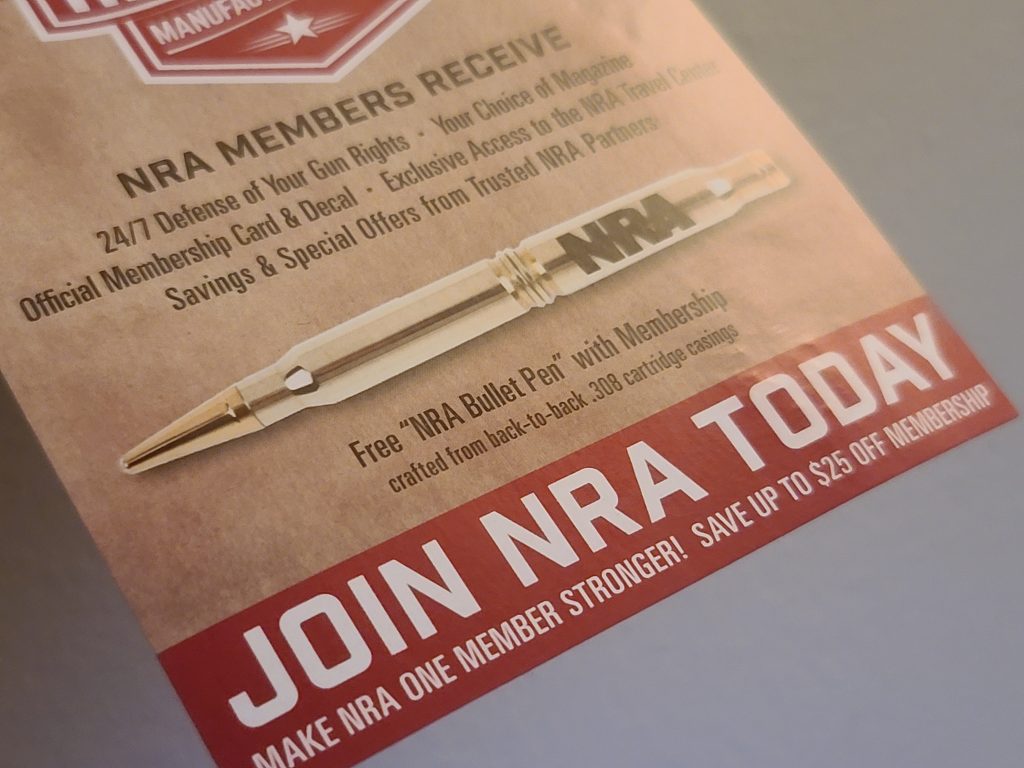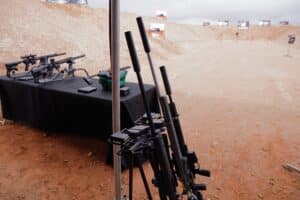This week wasn’t much brighter than last, sadly. We saw the situation in Afghanistan and the situation with Covid deteriorate further. Hopefully, the light at the end of the tunnel gets here sooner than later.
I’m back from the Farm now. That trip went well and I got to spend some quality time with my grandparents and close friends as well as the horses and the chickens. I hope you have been able to find something to bring you some joy over this past week too.
I think there’s always something positive we can find in times like this to get us through. Sometimes you just have to look a bit harder for it.
Unfortunately, you won’t find much to brighten your outlook in the latest gun news. Covid shut down the NRA’s annual meeting which will likely have profound impacts on the group for several reasons I discuss below. And the CDC has waded back into the troubled waters of government-funded gun research, where it will have to be careful if it doesn’t want to alienate large swaths of the American public.
This week’s podcast does offer some more uplifting content. I speak with some of the leaders of Asian American and Pacific Islander Gun Owners (AAPIGO) about the efforts they’ve undertaken in the few short months they’ve existed. And we talk about where they plan to go from here.

Analysis: The CDC Needs to Tread Lightly on Gun Research to Avoid Sowing Further Distrust [Member Exclusive]
By Stephen Gutowski
Center for Disease Control (CDC) Director Dr. Rochelle Walensky gave an interview on Friday promising the agency would go “pedal to the metal” with gun-violence research. But the agency’s approach needs to avoid crashing into past ditches if it hopes to do more than just sow distrust.
The disheartening rise in murders inside some of the country’s largest cities demands action. Dispassionate research into the root causes of gun violence could produce useful insights for lawmakers looking to blunt the homicide spike. And that’s what Walensky is promising to do.
“I’m here about preventing gun violence and gun death,” she told CNN.
Walensky promised to work with gun owners in the new CDC initiative. She said the goal was to prevent gun violence, not gun ownership.
“We cannot understand the research of firearm violence, firearm injury, without embracing wholeheartedly, the firearm owning community,” she said. “I really do believe that the population of people who wants to own a gun doesn’t want people hurt by them. The majority of the population does not want people hurt by them. I want them at the table.”
But gun owners and gun-rights activists have good reason to be skeptical of the rebirth of CDC research on guns. While major media outlets generally ignore it, there is a legitimate reason why Congress placed strings on gun research in the first place.
In 1994, Dr. Mark Rosenberg was director of the CDC’s National Center for Injury Prevention and Control. He was also explicitly anti-gun. He openly advocated for using a public health approach to gun violence that ends with literal bans.
“We need to revolutionize the way we look at guns, like what we did with cigarettes,” he told The New York Times. “It used to be that smoking was a glamour symbol, cool, sexy, macho. Now it is dirty, deadly, and banned.”
Naturally, this sowed a lot of distrust of the CDC among gun owners. Public Health Officials are not supposed to be political activists, and overtly advocating for a certain political outcome when you’re engaging in a scientific study does a lot to discredit your work. It also damages the trust a government institution relies on to influence the public.
That’s why Congress banned the use of CDC funds to promote gun control. The ban didn’t extend to all research on guns and, despite Walensky’s claims, federally-funded gun studies have happened in recent years. Though, certainly, the ban did drastically reduce the number of federally-funded gun studies.
Of course, academic study of gun violence didn’t cease by any means. A great deal of gun research has continued to happen without federal funding.
And it is odd to watch the CDC director begin speaking out about the agency focusing on gun violence, which is not a disease to be controlled no matter what language games some might like to play, in the middle of an actual pandemic. Yes, murder has spiked in some cities, and that deserves study. But it’s difficult to imagine how Walensky found time for this interview or why she’s prioritizing the inevitably-controversial study of guns while the Covid delta variant ravages large swaths of the country, causing hospital bed shortages.
The CDC is already facing a credibility problem among significant portions of the population. That’s at least partially due to their own communications missteps made throughout the pandemic. And repeating the mistakes of the 90s by delving into politically-motivated action on guns will only further erode their credibility.
The fact that Walensky’s promise for immediate action on gun research comes at the same time gun-control activists have been publicly clamoring for President Joe Biden (D.) to take more action on guns isn’t a great start. After all, the ban on funding for research that promotes gun control was lifted back in 2018. And murder began to surge last year.
In fact, the CDC had already initiated gun-violence research projects before Walensky’s interview. So, the timing of her forceful commitment that “something has to be done” about guns is a bit odd.
But the studies themselves are what matters more than the director’s rhetoric or promises. Looking through the ones the CDC has already funded, they’re mostly focused on violence interruption or looking at the effects of being exposed to violence. There is one that could stir up controversy depending on how it actually plays out, though.
The agency has given $349,829 to a researcher at the Rand Corporation who is trying to estimate the gun ownership rates in small areas and then conduct “innovative and more sensitive and precise evaluations of the effects of policies designed to improve firearm safety.” You could read the summary of the proposal a few different ways, given that “policies designed to improve firearm safety” could mean something very different depending on which side of the gun divide you’re on.
For most gun owners, a policy “designed to improve firearms safety” sounds like a gun safety rule, such as always keeping your gun pointed in a safe direction. But for gun-control activists, who now prefer the label “gun safety” activists, it usually means government policies designed to restrict the ownership or use of firearms.
The summary reads like the latter to me as differing gun laws are the only kind of “policies designed to improve firearms safety” it would make sense to study in this context, given gun safety rules are universal and gun laws are not. If that’s the case, it’s likely to produce some very controversial results one way or the other. And, if the CDC doubles back down on funding studies gun owners believe are designed to target them and their rights, the funding debate will make a come back very soon.
“I’m not here about gun control,” Walensky said on Friday.
She’ll need to make sure the agency treads lightly for anyone to believe her.
Podcast: Members of Asian American and Pacific Islander Gun Owners (AAPIGO) Discuss Minority Gun Rights [Member Early Access]
By Stephen Gutowski
On this week’s episode, I talked to three members of Asian American and Pacific Islander Gun Owners leadership team.
Scott Kane, Bobby Yang, and Raphael Platte joined me to discuss the new group’s recent range day as well as their concealed-carry permit protest event. The three are relative newcomers to the world of gun-right activism but they’ve identified a need in the gun-owning community and are trying to fill it. They talked about their efforts to engage with Asian-Americans interested in owning guns and what they plan to do moving forward to grow the group.
We also talked a bit about why a group specifically designed to appeal to Asian-Americans is necessary and how it can offer services and a form of community other groups can’t or won’t.
Scott talked about his family’s run-in with racist intimidation that inspired him to buy a gun at the beginning of the pandemic. Bobby also gave insight into how this activism plays into the greater political awakening of Asian-Americans in the wake of rising hate crimes. Plus, the three talk about their shared background in the tech world and how that informs their activism.
Give it a listen. I think you’ll really enjoy it! And, when you’re done with The Weekly Reload Podcast, check out the new Active Self Protection Podcast where I’ll be giving a weekly news update.
You can find the full podcast here.
Or you can watch the video podcast on YouTube.

Analysis: What the NRA Canceling Their Annual Meeting Means for the Gun Group [Member Exclusive]
By Stephen Gutowski
The NRA hit yet another roadblock this week when it was forced to cancel its Annual Meeting.
The announcement came just a week before tens of thousands of NRA members were set to descend on Houston, Texas, to attend the 150th-anniversary meeting. It came after concerns started to mount over the surge of Covid cases in the state. And it’s bad news for the group’s finances.
The Annual Meeting is the biggest fundraising event of the year for the NRA. It had to cancel last year’s event. Now this year’s is down the drain, too, after it had already booked the biggest convention center in Houston and planned the whole event.
So, the group is not only missing out on the membership and merchandise sales it would have had, but it will likely take a substantial hit for the last-minute cancelations.
That’s the kind of financial hit it can’t really afford either. Leaked financial documents show the NRA’s income cratered in 2020 while its legal expenses skyrocketed. After breaking ties with outside marketing firm Ackerman McQueen in 2019, the group has essentially moved the $40 million it was spending on them into the accounts of Brewer Attorneys.
The NRA has spent over $25 million in legal fees each year since 2018. It hit that $40 million mark in 2020. And It has already spent over $22 million this year, mostly on the failed bankruptcy gambit Brewer masterminded.
Only massive spending cuts in other areas including the gun-safety training division put the group back in the black in 2020. More may be coming to keep it there in 2021.
The cost is not the only problem with the cancelation. The way it happened is a bad sign too. It wasn’t until after big gun companies started dropping out of the event that the NRA finally canceled.
Late last week, the Daily Beast reported that most major gun makers were baking out of the event over Covid. Benelli confirmed that to me. The Beast report went a step further and said many companies had been privately pressuring the NRA to cancel the whole thing.
Sources inside the NRA and the industry told me this week that was true. And that it had been going on for several weeks. And many people in the industry eventually decided to walk.
That’s a bad sign for the group’s influence. The ongoing legal fight over accusations that NRA CEO Wayne LaPierre and other executives diverted members’ money to lavish personal expenses may have lowered the bar for when gun companies are willing to go against the group’s wishes. There has been some speculation that the backouts were more about opposition to LaPierre than concerns over Covid.
I don’t think that’s true. If it were, the companies wouldn’t have signed up to sponsor in the first place. Instead, the controversy and continued legal action against the group’s leadership made it easier for these companies to back out when they became concerned about the rise in Covid cases. Whether the NRA wanted them to or not.
That’s all I have for now. I’ll talk to you all again soon.
If you have any questions or suggestions for guests I should have on future episodes of the podcast, let me know!
Thanks,
Stephen Gutowski
Founder
The Reload







